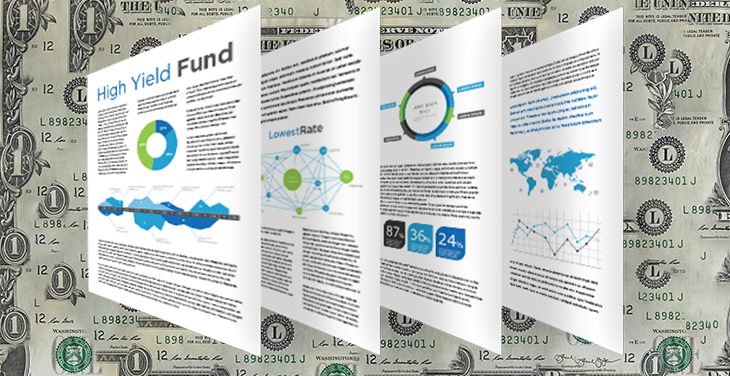In a budget-conscious financial services industry, marketing spend is a top concern. That’s why, when we meet new firms looking to invest in automating their factsheet production, one of the first questions marketers ask is, ‘How much will factsheet automation it cost?’. Before digging into their business requirements, our dreaded answer is: It depends. There are many factors to be considered. Firms take many approaches, and one size does NOT fit all.
Among the major dependencies affecting the cost of automating your marketing documents are:
- Complexity of your designs
- Number of templates and variations you have
- Complexity of your data
- Extent of your language requirements
- Amount of flexibility you have with requirements
- Number of documents to be produced
The complexity of your factsheets and flexibility of your firm’s operating model will ultimately determine the cost for automating them during production. To give you a better idea of what this means, let’s look at a few common scenarios. These are actual case studies of companies who have implemented factsheet automation recently with Synthesis and how much it cost them.
A Fully Custom Approach
Firm A: Larger firm, with more budget and internal resources
Key Concerns: Scalability, custom branding, reliability, ROI
Implementation Cost: $66k to $115k
The first firm, a larger firm, had over 50 products and multiple share classes. When we started the process, they had complex business rules for how components should be displayed. They also had complicated, yet somewhat consistent, design templates for their documents. Their data was coming from multiple data sources, mostly in large XML files.
Importantly, with this number of products and strict compliance oversight, they required a full disclosure library and footnote placement configuration. This feature set is often overkill for a smaller firm, but very common for larger firms with global distribution.
They had more specificity with regard to their template designs and data management requirements. Their main concern was getting documents out the door in the most automated, accurate, and low effort way possible. They required a full custom implementation, where templates were designed perfectly to their specs and data files were loaded in multiple different ways. They did not want any manual intervention in their streamlined data loading process.
Because this firm had a lot of complexity in their process, they weren’t able to utilize a standard approach to layout designs and data processing. As a result, their implementation approach had to be fully customized, costing them around $75k for their factsheet setup. They also planned to implement automation for their presentation pages, commentaries, sales ideas, and website content, leveraging their new data process. Costs for those efforts were not included in the $75k, but it was useful to know of these future requirements in planning the initial custom project work.
Before automation, the firm was spending a lot of time and resources to support document creation and synchronization of their various document types. The ROI on this investment was strong enough that the project paid for itself in about 2-years of operation.
A Semi-Custom Approach
Firm B: Medium-sized, mid-size budget expectations
Key Concerns: Enabling growth and reducing risks
Implementation cost: $38k to $55k
The second firm had 18 products and some document automation processes already in place. However, the existing processes weren’t scalable and couldn’t handle the firm’s complex data scenario with data coming from multiple sources. As a result, they were failing to hit their time-to-market goals and spending too much on internal resources. Without the staff resources to commit to their data management process, they wanted it to be as automated as possible.
Due to the complexity of their data scenario, we created custom data loaders for them and set up an automated and repeatable process to ingest data from their various sources for each production cycle. Although configuring and testing custom load-scripts added to implementation costs, it greatly reduced risk and time-to-market issues.
Despite the fact they needed a high level of customization for data management, this firm was more flexible with regard to their design templates. They started with a standardized “Theme” for their documents, then altered the theme to fit their needs. More specifically, they added 10 custom components that weren’t included in the standard set.
They were willing to conform to some standard pre-set themes and data formats. Yet, they still needed a decent amount of customization to accommodate their complex data process and unique data visualizations (charts/graphs). As a result, their implementation price-point ended up at $42,000.
The Stock Template Approach
Firm C: Small and extremely cost-conscious
Key Concerns: Freeing up limited resources, not breaking the bank
Implementation Cost: $25k to $30k
The third firm had 10 mutual fund products and wanted to improve efficiency in their operations. They were working with very few internal marketing resources. Their existing documents could have benefited from design improvement (and automation). However, the cost of paying for each of these projects was well beyond their reach. They did, however, want highly functional and professionally designed visuals and an extremely reliable process. Given these constraints, they were open to using a standardized design template for their documents. Their flexibility with design reduced their project costs significantly.
Like many others, they were working with limited internal data management tools and a variety of third-party data. While we could have built custom data loaders for them, we didn’t need to. They were willing to adopt our standardized data forms and file formats. This contributed to their cost savings as well.
Even while using a standardized design and data process, this firm was still able to adopt design elements and data visualizations most important to their company. Branding elements like color palette specifications, logos, and fonts were customized to their needs. For a small additional fee, they added a custom chart that wasn’t included in the standardized component list.
In this scenario, they paid around $25,000 for implementation. The main factor in keeping their costs low was their willingness to conform to a standard design and data process with little custom variation. This may be the best way to go for a small firm with both budgeting and staffing constraints. The resulting system provides an extremely positive return on investment, even at their small scale of operations.
Moral of the story:
It’s no surprise that the higher the client’s complexity, the higher the cost of automating factsheet production, and vice versa. What’s important to note, however, are the decisions firms were able to make to control their costs. Those decisions range from design to data prep to the true need for advanced features, like full disclosure management. No matter the cost required to implement and maintain your automation solution, the important metric to focus on is ROI. Is the investment going to be worth it, and how long until you see the benefit? It’s crucial to consider the internal and external costs and weigh those against the cost of doing business today. Let us know if we can help you!





